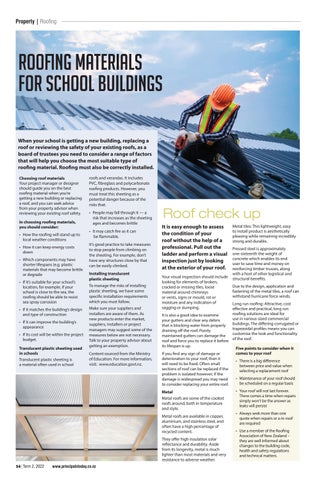Property | Roofing
Roofing materials for school buildings When your school is getting a new building, replacing a roof or reviewing the safety of your existing roofs, as a board of trustees you need to consider a range of factors that will help you choose the most suitable type of roofing material. Roofing must also be correctly installed. Choosing roof materials Your project manager or designer should guide you on the best roofing material when you’re getting a new building or replacing a roof, and you can seek advice from your property advisor when reviewing your existing roof safety. In choosing roofing materials, you should consider: • How the roofing will stand up to local weather conditions • How it can keep energy costs down • Which components may have shorter lifespans (e.g. plastic materials that may become brittle or degrade • If it’s suitable for your school’s location, for example, if your school is close to the sea, the roofing should be able to resist sea spray corrosion • If it matches the building’s design and type of construction • If it can improve the building’s appearance • If its cost will be within the project budget. Translucent plastic sheeting used in schools Translucent plastic sheeting is a material often used in school
roofs and verandas. It includes PVC, fibreglass and polycarbonate roofing products. However, you must treat this sheeting as a potential danger because of the risks that: • People may fall through it — a risk that increases as the sheeting ages and becomes brittle • It may catch fire as it can be flammable. It’s good practice to take measures to stop people from climbing on the sheeting. For example, don’t have any structures close by that can be easily climbed. Installing translucent plastic sheeting To manage the risks of installing plastic sheeting, we have some specific installation requirements which you must follow. Make sure your suppliers and installers are aware of them. As new products enter the market, suppliers, installers or project managers may suggest some of the measures below are not necessary. Talk to your property advisor about getting an exemption. Content sourced from the Ministry of Education. For more information, visit: www.education.govt.nz.
Roof check up It is easy enough to assess the condition of your roof without the help of a professional. Pull out the ladder and perform a visual inspection just by looking at the exterior of your roof. Your visual inspection should include looking for elements of broken, cracked or missing tiles, loose material around chimneys or vents, signs or mould, rot or moisture and any indication of sagging or slumping. It is also a good idea to examine your gutters and clear any debris that is blocking water from properly draining off the roof. Poorly maintained gutters can damage the roof and force you to replace it before its lifespan is up. If you find any sign of damage or deterioration to your roof, then it will need to be fixed. Often small sections of roof can be replaced if the problem is isolated however; if the damage is widespread you may need to consider replacing your entire roof. Metal Metal roofs are some of the coolest roofs around, both in temperature and style. Metal roofs are available in copper, aluminium, and stainless steel, and often have a high percentage of recycled content. They offer high insulation solar reflectance and durability. Aside from its longevity, metal is much lighter than most materials and very resistance to adverse weather.
54 | Term 2, 2022 www.principalstoday.co.nz
Metal tiles: This lightweight, easy to install product is aesthetically pleasing while remaining incredibly strong and durable. Pressed steel is approximately one-sixteenth the weight of concrete which enables its end user to save time and money on reinforcing timber trusses, along with a host of other logistical and structural benefits. Due to the design, application and fastening of the metal tiles, a roof can withstand hurricane force winds. Long run roofing: Attractive, cost effective and practical, long run roofing solutions are ideal for use in various sized commercial buildings. The differing corrugated or trapezoidal profiles means you can customise the look and functionality of the roof. Five points to consider when it comes to your roof • There is a big difference between price and value when selecting a replacement roof • Maintenance of your roof should be scheduled on a regular basis • Your roof will not last forever. There comes a time when repairs simply won’t be the answer as leaks will persist • Always seek more than one quote when repairs or a re-roof are required • Use a member of the Roofing Association of New Zealand – they are well informed about changes to the building code, health and safety regulations and technical matters.













